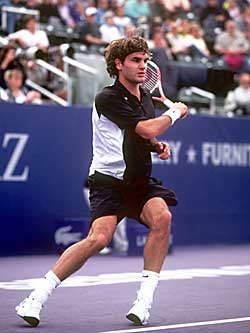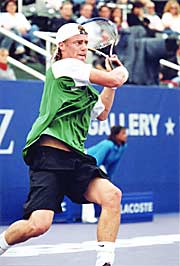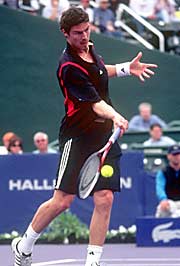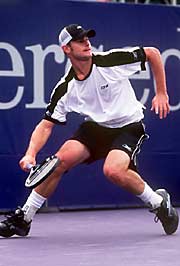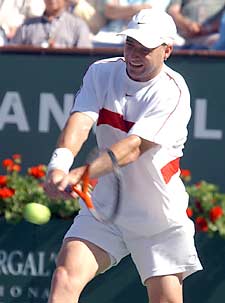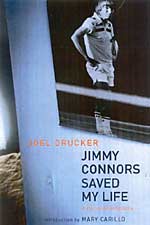|
TennisOne Features
Can Anyone Top Roger? By Joel Drucker Photos by Bill Putman
On a Sunday night in Houston, Roger Federer capped the best year a male player has had since Rod Laver swept all four Slams in 1969. Given the various surfaces Federer won on in 2004 – from the Rebound Ace of Australia to the grass of Wimbledon to the U.S. Open's hardcourt and a smattering of others – and the constantly-increasing depth of the tour, his achievement might even be greater than Laver's. But I'm not just yet about to join the chorus that proclaims Federer the best player in the history of tennis. He has unquestionably performed superbly over the last 18 months, the equivalent of a baseball player hitting .400. Though it's hard to believe Federer can continually win three or more Slams a year, certainly he's got the diversified and textured kind of game necessary for a good run at the top. Having already won Slams at three venues, he's no doubt got this sights set on the French Open. Make no mistake, Federer's got the game to win in Paris. He demolished Guillermo Coria in the finals of the Tennis Masters Hamburg event, and though he was beaten early in the French this year, that loss came at the hands of three-time champ Gustavo Kuerten. Certainly it would be great to see Federer win Roland Garros. It would be powerful testimony to the value of allcourt play. Of course it might also deplete him for Wimbledon. But on a bigger note regarding Federer, to me entering the pantheon of greats requires not just sustained performance, but also dominance and, finally, longevity. Three years from now we'll have a much clearer idea of where Federer's likely to stand. It's certainly reasonable to think that by the end of 2007 he could have seven or eight Grand Slam titles. Should he reach double-digits by that stage we might well be looking at something incredibly special.
Much of Federer's fate rests in the hands of his rivals. It was encouraging to see Andy Roddick trying to add new wrinkles to his game – attacking the net, a better backhand -- during the high-stakes Masters Cup last week in Houston. Lleyton Hewitt fights so well that despite losing to the Swiss at four big events, all year he brought out the best in Federer (much as Michael Chang, Hewitt's stylistic ancestor, did with Pete Sampras).
Marat Safin's also one worth paying close attention in '05. So talented, yet so flighty, Safin's 2004 resembled a poorly-constructed sandwich: two big pieces of bread at both ends, but little inside. He started the year with a grand effort in Australia, winning rough five-setters versus Roddick and Andre Agassi to reach the final. There followed months of lousy tennis, best symbolized by a tank job at Wimbledon and a desultory first-round loss to Thomas Enqvist at the U.S. Open. But then the Russian finished the year in grand style, taking Masters Series events in Madrid and Stuttgart before losing in the semis of Houston to Federer. That match's 20-18 second-set tiebreak – tying the Open-era record – was a gem. And what of Andre Agassi? At 34 he impressively remains a top ten player. His ability to take balls early presses Federer, as seen in their windswept five-setter in the quarters of the U.S. Open. Certainly Agassi's also got the goods to outmaneuver Hewitt and outthink Safin, particularly in a two-out-of-three set match. It will be intriguing to see how well Agassi plays at the Australian Open. But to me none of these contenders quite plays the way I believe can most challenge Federer. Though a superb volleyer, he's not particularly disposed to attack. Instead, like most great Europeans, he enjoys working the ball around from the baseline, massaging his opponents into disarray and then striking. At times he reminds me of that old claycourter, Manolo Orantes, only with significantly more firepower. I'd like to see someone come along who can jolt Federer out of his comfort zone, a player with a serve and volley barrage that's forceful and committed enough to force Federer into hitting dozens of backhand passing shots.
Dutchman Richard Krajicek used to play this way versus Pete Sampras, causing Sampras all sorts of headaches. To a lesser degree, Stefan Edberg and Patrick Rafter troubled Sampras too. Though lacking big serves, each struck those annoying kickers and came to net intrepidly. There isn't a contemporary player who quite has either of these gifts. Mark Philippoussis has the serve, but lacks the agility to force Federer into hitting passing shots from tough spots. Tim Henman's serve lacks the zip. Taylor Dent's missing a bit in each area. But somewhere, on a court we don't know, let's hope there's a lanky 16-year-old working on his serve and volley. I love Federer – so much that I want to see him even more tested. Your comments are welcome. Let us know what you think about Joel Drucker's article by emailing us here at TennisOne .
Jimmy Connors Saved My Life: A Personal Biography Longstanding TennisOne writer Joel Drucker has just published his first book, Jimmy Connors Saved My Life: A Personal Biography. Mr. Drucker provides the most thorough examination ever attempted of one of the most complex characters in recent sports history. The book is both a comprehensive biography of the controversial tennis star and a look at how the author's life intersected and conflicted with Jimbo's. The book includes extensive analysis of Connors' tennis, including the vital impact his mother had as his primary coach, as well as the significant work the great Pancho Segura did in his formative years. Also covered are a great many of Connors' most important matches, as well as many personal interactions Drucker had with Connors that reveal unusual sides to him. |

